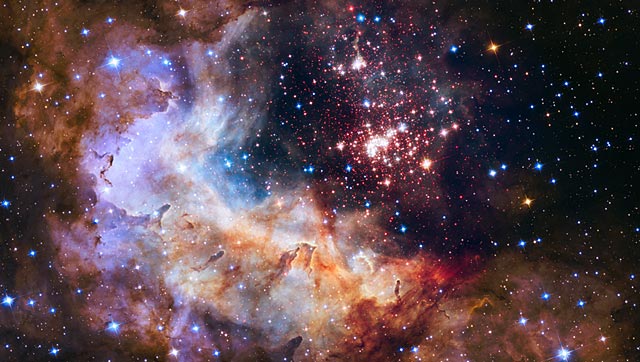NASA on Thursday marked the silver anniversary of the Hubble Space Telescope with fireworks, of a celestial kind, conveyed by the orbiting observatory itself.
To commemorate Hubble’s launch on April 24, 1990, NASA selected a picture of a stellar nursery located about 20,000 light-years away in the constellation Carina. (see picture above)
“This is really an exciting week for astronomers and people who love astronomy all over the world,” said Hubble scientist Jennifer Wiseman at a televised anniversary celebration at the Newseum in Washington, DC.
From its orbital perch 340 miles (547 km) above Earth, Hubble’s sharp eye can distinguish individual stars in the cluster, which is teeming with about 3,000 newborns. With its infrared vision, Hubble also can peep inside cocoons of dust and gas where even more stars are forming.
Learning about the lifecycle of stars was one of the reasons Hubble was built. By operating above distortions and blocking effects of Earth’s atmosphere, astronomers hoped to look farther back in time, at generations of stars and galaxies that formed closer to the Big Bang, some 13.7 billion years ago.
The 50-year development effort nearly ended after Hubble’s launch, when NASA discovered a manufacturing flaw in the telescope’s 94-inch (2.4-meter) diameter mirror. Corrective optics, installed by space-walking astronauts, saved the day in 1993, the first of five servicing calls by space shuttle crews.
“We never thought it would last this long,” said NASA administrator and former astronaut Charlie Bolden, the pilot on the mission that launched Hubble.
Many of the telescope’s most important discoveries turned out to be in areas that didn’t even exist when it was launched. Hubble’s observations of a particular kind
of exploded star helped astronomers realize that the pace of the universe’s expansion is ramping up, propelled by some unknown force referred to as ‘dark energy.’
Hubble also has imaged a planet beyond the solar system and scanned other planets’ atmospheres for telltale chemical fingerprints. The first so-called exoplanet was discovered in 1992, two years after Hubble’s launch.
“Hubble has fundamentally changed our human understanding of our universe,” Bolden said.
NASA hopes to keep Hubble operating through 2020 to overlap with its infrared successor, the James Webb Space Telescope, due to launch in October 2018.
On this occasion HT brings out 25 selected images of our universe taken by the Hubble telescope in its 25-year long service.
Images and description credits : NASA, ESA
Jupiter’s Great Red Spot
Distance: 5th planet from the Sun; average distance from the Sun is 778 million km (484 million miles) or 5.2 astronomical units (AU)
Credits: NASA, ESA, and A. Simon (Goddard Space Flight Center)
Located nearly 500 million miles away, the giant planet Jupiter’s atmosphere is a roiling cauldron of activity. It includes lightning, oppositely moving cloud belts, and hundreds of rotating storms that appear as large red, white, or brown ovals. The largest of these storms is the legendary anticyclone called the Great Red Spot (GRS). In fact, the GRS is the largest known storm in the solar system.
Saturn
Distance: 6th planet from the Sun; average distance from the Sun is 1.4 billion km (886 million miles) or 9.5 astronomical units (AU)
Credits: NASA, ESA, and the Hubble Heritage Team (STScI/AURA)
Saturn is famous for the intriguing rings that encircle it. As Saturn orbits the Sun, though, our view of its rings changes. Roughly every 15 years (halfway through Saturn’s almost-30-year orbit), Saturn’s rings appear edge-on, sometimes seeming to disappear altogether. Because many of Saturn’s moons orbit the planet in the same plane as the rings, they appear to cross in front of the planet during this time.
Orion Nebula
Constellation: Orion
Distance: 1,300 light-years
Credits: NASA, ESA, M. Robberto (Space Telescope Science Institute/ESA), and the Hubble Space Telescope Orion Treasury Project Team
The Orion Nebula is a tumultuous region of dust and gas where thousands of stars are being born. Located 1,300 light-years away, it is the nearest area of star formation to Earth. In one of the most detailed astronomical images ever produced, Hubble captured an unprecedented look at this nebula.
Horsehead Nebula
Constellation: Orion
Distance: 1,500 light-years
Credits: Credit: NASA, ESA, and the Hubble Heritage Team (STScI/AURA)
The iconic Horsehead Nebula has graced astronomy books ever since its discovery more than a century ago in 1888 by Scottish astronomer Williamina Fleming. The nebula is a favorite target for amateur and professional astronomers alike. Hubble’s infrared vision shows it in a dramatic new light. The nebula, shadowy in optical light, appears transparent and ethereal when seen at infrared wavelengths, represented here with visible shades.
Planetary Nebula NGC 5189
Constellation: Musca
Distance: 1,800 light-years
Credits: NASA, ESA, and the Hubble Heritage Team (STScI/AURA)
Planetary nebulae represent the final, brief stage in the life of a medium-sized star like our Sun. While consuming the last of the fuel in its core, the dying star expels a large portion of its outer envelope. This material is then illuminated by the ultraviolet radiation from the stellar remnant, producing glowing clouds of gas that can show complex structure.

